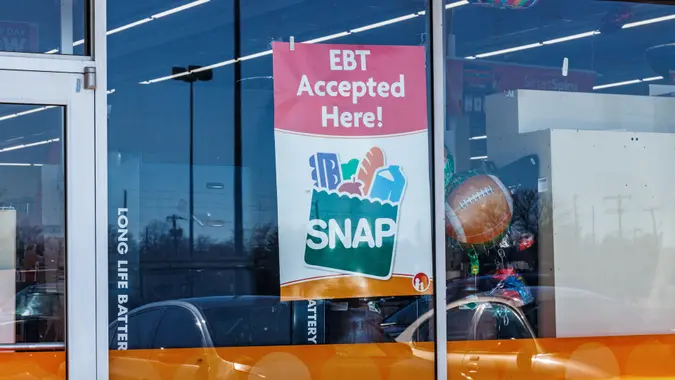Food Stamps: Ohio Will Adjust Income Limits Starting in October 2022

Commitment to Our Readers
GOBankingRates' editorial team is committed to bringing you unbiased reviews and information. We use data-driven methodologies to evaluate financial products and services - our reviews and ratings are not influenced by advertisers. You can read more about our editorial guidelines and our products and services review methodology.

20 Years
Helping You Live Richer

Reviewed
by Experts

Trusted by
Millions of Readers
The Ohio Food Assistance Program, or the Supplemental Nutrition Assistance Program (SNAP) as it is known nationally, assists eligible low-income Ohioans with food insecurity by providing monthly funding and nutrition information to individuals and households in need.
As Jennifer Rodriguez of WKBN reports, the USDA’s cost-of-living adjustments for SNAP benefits will go into effect on Oct. 1, 2022, giving a much-needed increase in food aid to even more Ohio families.
The program’s maximum monthly food allotments will increase from $250, $459 and $835 for a single individual, a couple and a four-person household to $281, $516 and $939, respectively. The minimum monthly allotment is being increased from $20 to $23, according to the Ohio Department of Job and Family Services.
The gross and net monthly income limits for households also are increasing Oct. 1. For example, a single-person household will now have a gross monthly income limit of $1,473 (up from $1,396) and a net monthly income limit of $1,133 (from $1,074). For a family of four, the maximum gross monthly income is $3,007 (from $2,871 in 2021) and the net monthly income is now $2,313 (from $2,209).
As GOBankingRates previously reported, in 2022 Ohio is home to about 1.38 million recipients who receive SNAP benefits, or 12% of the state’s population. The average benefit — per household member, per month — is $132.
According to the Ohio Department of Job and Family Services, the maximum net and gross monthly income limits — as well as the adjusted separate income maximums (for elderly and disabled individuals and households) and the maximum monthly allotments (AG, or assistance group, size indicates the number of eligible household members) — follow.
Net Income Standards (100% of poverty):
| AG Size | Maximum Income |
| 1 | $1,133 |
| 2 | $1,526 |
| 3 | $1,920 |
| 4 | $2,313 |
| 5 | $2,706 |
| 6 | $3,100 |
| 7 | $3,493 |
| 8 | $3,886 |
| each additional | +$394 |
Gross Income Standards (130% of poverty):
| AG Size | Maximum Income |
| 1 | $1,473 |
| 2 | $1,984 |
| 3 | $2,495 |
| 4 | $3,007 |
| 5 | $3,518 |
| 6 | $4,029 |
| 7 | $4,541 |
| 8 | $5,052 |
| each additional | +$512 |
Separate AG Income Standards — Elderly and Disabled AGs Only (165% of poverty):
| AG Size | Maximum Income |
| 1 | $1,869 |
| 2 | $2,518 |
| 3 | $3,167 |
| 4 | $3,816 |
| 5 | $4,465 |
| 6 | $5,114 |
| 7 | $5,763 |
| 8 | $6,412 |
| each additional | +$649 |
Maximum Food Assistance Allotments:
| AG Size | Maximum Allotment |
| 1 | $281 |
| 2 | $516 |
| 3 | $740 |
| 4 | $939 |
| 5 | $1,116 |
| 6 | $1,339 |
| 7 | $1,480 |
| 8 | $1,691 |
| each additional | +$211 |
| Minimum Allotment | $23 |
 Written by
Written by  Edited by
Edited by 

























